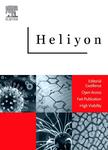版权所有:内蒙古大学图书馆 技术提供:维普资讯• 智图
内蒙古自治区呼和浩特市赛罕区大学西街235号 邮编: 010021

作者机构:Department of Biochemistry Faculty of Science Ebonyi State University Abakaliki Nigeria Department of Biochemistry Faculty of Biomedical Sciences Kampala International University Uganda Department of Physiology School of Medicine Kabale University Kabale Uganda Department of Anatomy and Cell Biology Faculty of Health Sciences Busitema University Uganda Department of Science Laboratory Technology Biochemistry Option Federal Polytechnic Oko Anambra State Nigeria Department of Medical Biochemistry Faculty of Basic Medical Sciences College of Medicine Alex-Ekwueme Federal University Ndufu-Alike Ikwo Ebonyi State Nigeria Protein Structure-Function and Research Unit School of Molecular and Cell Biology Faculty of Science University of the Witwatersrand Braamfontein Johannesburg 2050 South Africa Department of Physiology Faculty of Biomedical Sciences Kampala International University Uganda Department of Human Anatomy Faculty of Biomedical Sciences Kampala International University Uganda
出 版 物:《Heliyon》 (Heliyon)
年 卷 期:2025年第11卷第2期
页 面:e41624页
主 题:C. mannii seed oil cyclophosphamide Liver and kidney toxicity Prophylactic efficacy
摘 要:This study aimed to determine whether C. mannii seed oil (CMSO) could shield rats from cyclophosphamide-induced hepatorenal toxicity. The focus was on its antioxidant and anti-inflammatory properties. We randomly assigned thirty-six (36) male Wistar rats into six groups of six rats each. Groups A and B served as normal and negative controls, respectively. Group C, the standard control, was administered 300 mg/kg body weight (bw) of Omega 3 oil for 27 days, followed by 100 mg/kg bw of cyclophosphamide on day 28. Group D, E, and F received 5, 2.5, and 1.5 ml/kg b.w. of CMSO for 27 days, then 100 ml/kg b.w. of cyclophosphamide on day 28. We measured the body weights of the experimental rats every week. Rats of all groups were sacrificed on day 30 and collected blood for biochemical analysis using standard methods. The phytochemical constituents were determined by the spectrophotometric method. The phytochemical study of CMSO indicated the relative composition of constituents(mg/100g) as phenols (30 %), tannins (20 %), flavonoids (18 %), terpenoids (15 %), glycosides (10 %), alkaloids (5 %), and HCN (2 %) in Cucumeropsis mannii seed oil. When cyclophosphamide was given to Wistar albino rats, it greatly decreased the activities of catalase (CAT) and superoxide dismutase (SOD), but it increased the activities of iNOS and the levels of MDA and IL-1β. Cyclophosphamide increased ALT (52.3 U/L), AST (48.7 U/L), ALP (46.5 U/L), total bilirubin (1.4 mg/dL), conjugated bilirubin (0.8 mg/dL), creatinine (0.8 mg/dL), urea (45.6 mg/dL), and BUN (15.7 mg/dL), with a reduction in the albumin (4.8 g/dL) level. Cyclophosphamide administration also caused hepatocellular necrosis, inflammatory leukocyte infiltration, tubular necrosis, and proteinaceous deposits in Bowman s space in the kidney. However, combining CMSO and Omega 3 oils significantly restored the altered histology architecture, antioxidant, inflammatory markers, and liver and kidney function parameters to levels comparable